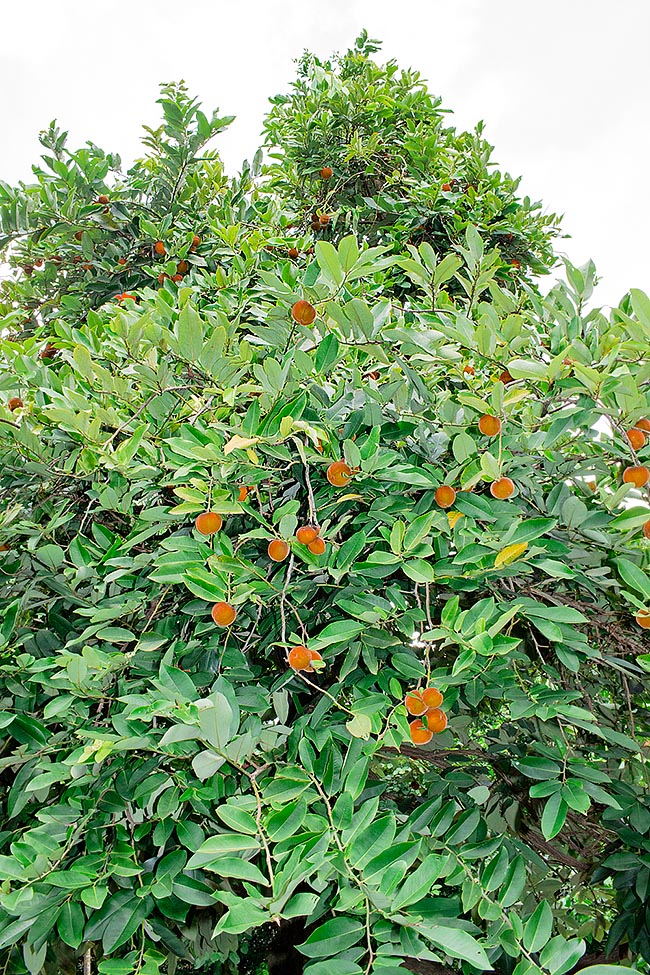Family : Ebenaceae

Text © Pietro Puccio

English translation by Mario Beltramini

Diospyros discolor is native to Borneo, Philippines and Taiwan where grows in the humid forests up to about 800 m © Giuseppe Mazza
The name of the genus is the combination of the Greek adjective “διός” (dios) = divine and of the substantive “πυρός” (pyros) = wheat, therefore, broadly speaking, ‘divine food’; the specific name is the Latin adjective “discolor, oris” = of different colours, referring to the difference in colour between the upper page and the lower one of the leaves.
Common names:butter fruit, mabola-tree, mabolo persimmon, velvet persimmon, velvet-apple (English); mao shi, tai wan shi, yi se shi (Chinese); kamagong, mabolo, mabulo (Tagalog); pommier velours (French); ke gaki (Japanese); belanti gab (Hindi); bisbul, buah lemah, buah mentega, buah sagalat, kamagong, kayu mentega (Malay); pécego-de-Índia (Portuguese); camagón (Spanish); ma-rit (Thai); hong nhung (Vietnamese).
The Diospyros discolor Willd. (1806) is an evergreen dioicus (each individual bears either only male flowers or only female ones), up to about 30 m tall in the old specimens in nature, with trunk of 30-60 cm of diameter, with dark brown bark and dense foliage with greyish branches initially pubescent, then glabrous.
The leaves, on a 0,5-2 cm long petiole, are alternate, simple, oblong-lanceolate with pointed and curved apex, 10-25 cm long and 5-11 cm broad, coriaceous, dark green and glossy above, silver grey and pubescent below; the young leaves are pinkish.

It’s a dioecious evergreen tree that can reach 30 m. The fruits are globose berries of 8-10 cm of diameter © G. Mazza
Axillar, solitary female flowers, of about 1,2 cm of diameter, with about 1 cm long tubular calyx deeply divided in 4 ovate lobes, 0,7 cm broad, of yellowish green colour and covered by a thick grey-brown down, persistent in fruit, imbutiform cream white corolla, about 1,5 cm long, with 4 ovate retroflexed lobes and 4-10 staminodes.
Male flowers in axillar cymes, slightly smaller than the female ones, with 12-15 biforked stamina at the apex.
The fruit is a globose slightly flattened berry, of 8-10 cm of diameter, reddish when ripe and covered by a thick and short brown-yellowish down, with firm whitish pulp, dry and astringent, rather pleasant, containing 0-8 clove-shaped seeds averagely 4 cm long, 2,5 cm broad and 1,5 cm thick, of dark brown colour.
It reproduces by seeds, that doesn’t have a long lasting germinability, previously kept in water for 2 days, in draining organic loam maintained constantly humid at the temperature of 24-28 °C, with germination times of 4-8 weeks and first fructification after 6-7 years; for reproducing a particular variety recourse is done to the cutting, air layering and grafting.
The young plants are at times utilized as rootstock for the Diospyros kaki L.f., (1782).
Relatively little known species out from its origin zones, where on the contrary is diffused in nature and also in cultivation, in particular in the Philippines, for ornamental purposes, due to the foliage, the perfumed flowers and the attractive fruits, and as shade tree in parks and gardens and along the roads, besides as windbreaks, seen its particular resistance to the strong winds.
Moreover, it is cultivated for the fruits, consumed raw, without the skin that has an unpleasant odour and whose down may cause irritations in the sensitive persons, in salads, boiled or fried, and for the wood, almost black, particularly hard and compact, with which are made prized furnitures, common use objects and artistic ones, tools and musical instruments.

The skin has unpleasant odour with irritant down, but the peeled fruit can be consumed in salad, boiled or fried. Prized almost black wood. Leaves, bark, juice of unripe fruits and seeds oil have medicinal virtues © G. Mazza
Leaves, bark, juice of the unripe fruits and the oil extracted from the seeds are utilized in the traditional medicine for various pathologies.
Synonyms:
Cavanillea philippensis Desr. (1792); Cavanillea mabolo Poir. (1794); Diospyros mabolo Roxb. ex J.V.Thomps. (1822); Diospyros mabolo (Poir.) Roxb. ex Lindl. (1828); Mabola edulis Raf. (1838); Embryopteris discolor (Willd.) G.Don (1847); Diospyros blancoi A.DC. (1844); Diospyros malacapai A.DC. (1844); Diospyros philippensis (Desr.) Gürke (1891); Diospyros utilis Hemsl. (1895); Diospyros merrillii Elmer (1913); Diospyros durionoides Bakh. (1933).
→ To appreciate the biodiversity within the EBENACEAE family please click here.
